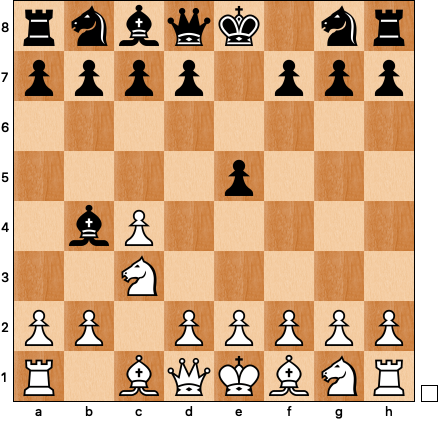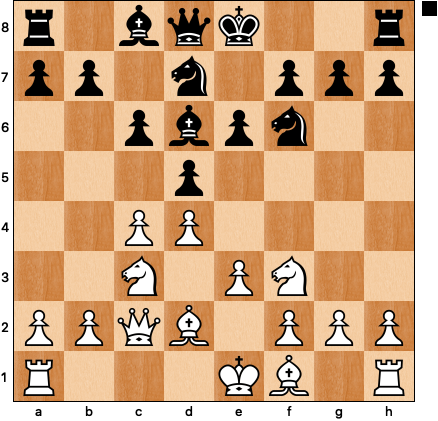Classical chess is dead? Not so fast, my friends — the annual Wijk aan Zee tournament is here, with an entertaining mix of top players and hungry young GMs, and through five rounds the chess has been unpredictable and exciting. From Giri’s near miss against Gukesh in round one to Harikrishna’s queenless miniature against Warmerdam in round four, there’s been something for everyone, but my personal favorite game was the first round battle between the tournament’s co-leaders, Praggnanandhaa and Abdusattorov.
The game began 1 c4 e5 2 Nc3 Bb4, and we should pause here to consider the meaning of this strange bishop move1:
The story of openings in the twentieth century is the evolution from classical theory (occupy the center, knights before bishops) to hypermodern theory (attack the center from afar, retain dynamic potential, fianchetto everything). The recent popularity of moves like 2 … Bb4 (the third most common move in this position) represents a third wave of opening theory, in which classical and hypermodern ideas are woven together to arrive at fresh and interesting positions. In this case, black occupies the center on his first move (classical theory), but lures white’s knight forward on the second (hypermodern).
3 g3 is not particularly promising, as black can capture on c3 with a reversed Rossolimo2, so the game continued 3 Nd5 a5. Black’s play creates a world full of temptation: it was tempting to hit the bishop with Nd5, now it’s tempting to grab the bishop pair by snapping on b4. But 4 Nxb4 axb4 is not particularly good, as black’s remaining minor pieces can be developed easily to their natural squares and the half open a-file will be a constant annoyance.
White often plays 4 a3, leaving black with a choice between 4 … Bc5 and 4 … Be7. Praggnanandhaa instead chose the subtle 4 Nf3, with the point that 4 … e4 is loosening and 4 … Nc6 misplaces the knight, which more often goes to d7 (since black wants to play c7-c6 to kick the Nd5). Abdusattorov played the most common and natural move, 4 … d6, but now after 5 a3 he was left with only one retreat, 5 … Bc5:
I’m no expert in this variation, but my sense is that Praggnanandhaa is playing quite cleverly, trying to pull black into a specific setup with the bishop on c5. It may look more active here than on e7, but after e3 and d4 (with tempo!) the dark-squared bishop will be biting on granite for some time to come3.
The next few moves are logical: white expands in the center and black catches up in development: 6 e3 c6 7 d4 Ba7 (I found one game in the database featuring the peculiar 7 … cxd5 8 dxc5 e4 9 Nd2 Nf6 10 cxd5 00) 8 Nc3 Nd7 9 Qc2 Ngf6 10 Bd2:
If his ninth move wasn’t a bit of a tell, 10 Bd2 fully telegraphs white’s intentions: castle queenside and throw the kingside pawns toward’s black’s king. It’s a risky choice — white usually plays 9 Be2 instead of Qc2 — but one with the potential to put a lot of pressure on an unprepared opponent. It also resembles one of white’s modern approaches against the Semi-Slav: 1 d4 d5 2 c4 c6 3 Nf3 e6 4 Nc3 Nf6 5 e3 Nbd7 6 Qc2 Bd6 7 Bd2:
Of course, 7 g4 is much more common in that Semi-Slav line than 7 Bd2, which led me to wonder if Praggnanandhaa could have tried 10 g4 instead. The computer calls it too bold: the game might continue 10 … Nxg4 11 Rg1 exd4! 12 exd4 (a little better is 12 Rxg4) 12 … Nde5! with some serious counterplay:
After Pragg’s Bd2, the game continued 10 … 00 11 000 Re8 12 h3 (white’s kingside play is a bit slow, but will arrive eventually if black doesn’t take action) 12 … e4 13 Nh2 (an improvement over another game in my database that continued 13 Ng1; it’s better to have the option of Ng4 later) 13 … d5:
My superficial assessment of this position is that I’d rather have the black pieces. Black has the center space of an Advance French with little corresponding white pressure on d5. The Nh2 looks oddly placed, and the a3 pawn is a potential hook with which to open a file if black can get in b5 and b4.
That said, 14 cxd5 cxd5 15 g4 would have been tricky to handle — perhaps not for Abdusattorov, but certainly for someone like me. White’s firm grip of b5 slows black’s play on the queenside, and the threat of g5 and Nxd5 is a potential problem. There could follow 15 … Nb6 16 g5 Nh5 (16 … Nfd7 allows 17 f4! when black doesn’t want to take en passant, but also doesn’t want to let the white pawns advance unimpeded) with two options for white:
The first is 17 Be2!? and now black pretty much has to go down a dangerous path: 17 … Qxg5 18 Rdg1 Qh6 19 Qd1 Nf6 20 Ng4 with a strong white initiative for only a small material investment. The computer assures me that this is equal, but practically speaking I think most people would prefer to play white’s side.
The second variation involves simply protecting the g-pawn: 17 h4 (17 f4 runs into 17 … Ng3) and now the computer recommends a rather counterintuitive method of preventing Ng4-e5 (or Ng4-h6 in some lines): 17 … Bb8! 18 Be2 Bxh2! 19 Rxh2 g6. Maybe Abdusattorov would have found this idea, but it’s hard to part with the dark-squared bishop once it lands on the wide open b8-h2 diagonal and hard to see why it’s more important to retain the Bc8 (which could also chop the knight upon arrival on g4).
To cut through all the silicon-based subtlety, the upshot here is that by trading on d5, white could have forced black on the defensive. Instead Praggnanandhaa chose 14 g4?! and after 14 … dxc4 15 g5 (15 Bxc4 b5 with b4 coming next is quite bad) 15 … Nd5 16 Nxe4 Qe7 17 Ng3 b5 he found himself in an uncomfortable position:
Blacks’ Nf6 is far better on d5 than it was on h5 in some of the preceding analysis, but more importantly, b5-b4 is now operational. There is no similar pawn break facing black on the kingside, and black is ready to seize the initiative. The game is just heating up, but the opening phase is over, so we’ll save the fascinating middle section for the next post.
A move that I would have considered a terrible mistake for most of my chess life: OMG, you can attack the bishop with tempo!
Another typical feature of these third wave openings is playing common systems with the colors reversed.
It’s also worth noting that one of the best positions Gukesh achieved in the World Championship match came from a similar variation with Be7 instead of Bc5: 1 c4 e5 2 Nc3 Bb4 3 Nd5 Be7 4 Nf3 d6 5 g3 c6 6 Nxe7 Nxe7 7 Bg2 f6, preparing d6-d5 with a big center.












Great explanation, I also tried to annotate a game... I found out how hard it is, but you did it well.